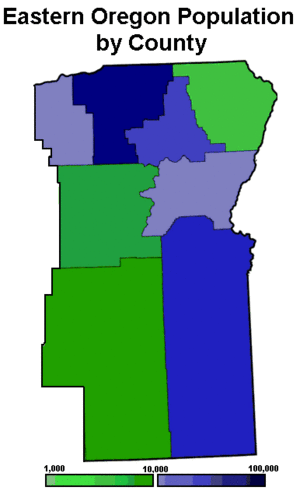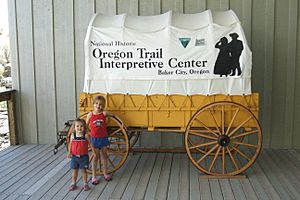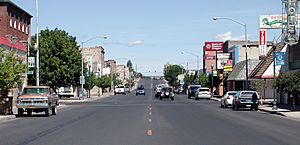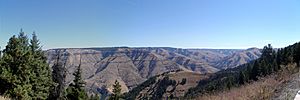Eastern Oregon facts for kids
Eastern Oregon is a large area in the eastern part of the U.S. state of Oregon. It's not an official area, so its exact borders can change. Sometimes, it means just the eight counties furthest to the east. Other times, it includes all the land east of the Cascade Range mountains.
Some of the main cities in Eastern Oregon are Baker City, Burns, Hermiston, Pendleton, and Ontario. Umatilla County has the most people in this region. Hermiston is the biggest city.
The main jobs here are in transportation, storage, timber, farming, and tourism. Major roads like I-84 help people and goods move around.
Eastern Oregon has a much drier climate than western Oregon. It gets more snow in winter. Some areas are very dry, like deserts, because the Cascade Mountains block the rain. Forests of pine and juniper trees cover about 35% of the area. These are mostly in the mountains like the Blue Mountains and Steens Mountain. Millions of years ago, volcanoes covered large parts of Eastern Oregon with lava.
Contents
Exploring Eastern Oregon's Geography

When people talk about Eastern Oregon, they usually mean eight specific counties. These are Morrow, Umatilla, Union, Wallowa, Grant, Baker, Harney, and Malheur.
These eight counties can be split into three smaller parts:
- The Columbia River Plateau (Morrow and Umatilla counties)
- Northeast Oregon (Baker, Union, and Wallowa counties)
- Southeast Oregon (Grant, Harney, and Malheur counties)
Sometimes, the definition of Eastern Oregon is even bigger. It can include all the land east of the Cascade Mountains. This would add counties like Deschutes and Klamath.
The very eastern tip of Oregon, near the city of Ontario, is part of the Treasure Valley. This valley stretches into Boise, Idaho. This small part of Oregon is in the Mountain Time Zone, unlike the rest of the state. The highest mountain in the region is Sacajawea Peak.
Major Cities in Eastern Oregon
Here are the 15 largest cities in Eastern Oregon, based on the eight-county definition:
| Rank | City | Population (2023) | County |
|---|---|---|---|
| 1 | Hermiston | 20,322 | Umatilla |
| 2 | Pendleton | 17,006 | Umatilla |
| 3 | La Grande | 12,823 | Union |
| 4 | Ontario | 12,206 | Malheur |
| 5 | Baker City | 10,102 | Baker |
| 6 | Umatilla | 7,810 | Umatilla |
| 7 | Milton-Freewater | 7,490 | Umatilla |
| 8 | Boardman | 4,437 | Morrow |
| 9 | Nyssa | 3,363 | Malheur |
| 10 | Burns | 2,730 | Harney |
| 11 | Union | 2,182 | Union |
| 12 | Stanfield | 2,313 | Umatilla |
| 13 | Enterprise | 2,147 | Wallowa |
| 14 | Irrigon | 2,133 | Morrow |
| 15 | Vale | 1,947 | Malheur |
Some larger cities like Bend and Klamath Falls are east of the Cascades. However, they are not usually counted in the stricter eight-county definition of Eastern Oregon.
Climate and Nature
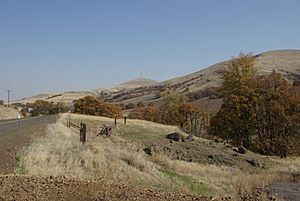
Eastern Oregon has a very different climate from western Oregon. Western Oregon is close to the Pacific Ocean and gets a lot of rain. Eastern Oregon is much drier. It has bigger changes in temperature between summer and winter.
Unlike the Willamette Valley in western Oregon, Eastern Oregon gets a lot of snow in winter. Some areas receive less than 10 inches (250 mm) of rain each year. This makes them deserts. The driest parts are in the southeast and near Redmond. This desert climate happens because of a "rain shadow" effect. The Cascade Range mountains block the rain clouds from reaching the eastern side.
About 35% of Eastern Oregon is covered in pine and juniper forests. These forests are mostly found in the mountains, like the Blue Mountains.
Economy and Jobs
The main type of work in Eastern Oregon is farming. Growing wheat is very important, especially in the northeastern part of the region. The rich soil here makes it one of the best wheat-growing areas in the world.
In areas where there is enough water for irrigation, farmers often grow alfalfa hay. In other parts, especially in the south, the land is mostly used for raising livestock like cattle.
In the past, Timber (logging) and mining were very important. Now, these industries are not as big as they used to be. New types of tourism are growing, like visiting farms (agritourism) and exploring nature (ecotourism).
Fun Things to Do
Eastern Oregon offers many outdoor activities. You can find everything from high deserts to rugged mountains.
- Skiing: Anthony Lakes is the biggest ski resort in Eastern Oregon. Spout Springs is another popular spot for families.
- Rafting: You can go rafting on rivers like the Owyhee River and the Snake River. Some river trips are calm, while others have exciting rapids.
- Hiking: The Eagle Cap Wilderness area and other mountainous regions offer great hiking trails.
Transportation and Travel
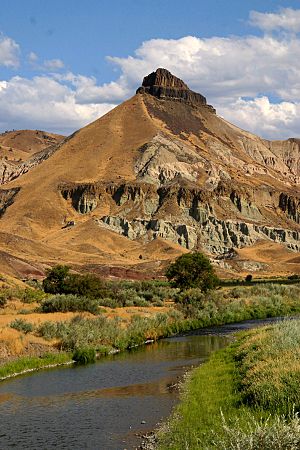
For a long time, it was hard to travel between Eastern and Western Oregon. This was because of the tall Cascade Mountains. Early settlers often used the Columbia River to get to Western Oregon.
In 1845, Sam Barlow built a road around Mount Hood. This road was the last part of the famous Oregon Trail. Other roads, like the Applegate Trail, were built later to connect the eastern and western parts of the state. In the early 1900s, the Historic Columbia River Highway was built. This made it easier for cars to travel through the Columbia River Gorge.
Railroads also helped connect Eastern and Western Oregon. The first trains arrived in Portland in 1883, linking the northern part of Eastern Oregon to the rest of the country. Later, another railroad line was built across southern Idaho, connecting to Eastern Oregon at Huntington. This line followed the path of the Oregon Trail.
Today, major roads help people travel through Eastern Oregon:
- I-84 runs from Ontario through the Columbia River Gorge.
- A short part of Interstate 82 also runs through the region.
- Other important east-west roads include U.S. Route 26, U.S. Route 30, and U.S. Route 20.
- Major north-south roads are U.S. Route 395 (passing through Pendleton and Burns) and U.S. Route 97 (passing through Klamath Falls and Bend).


